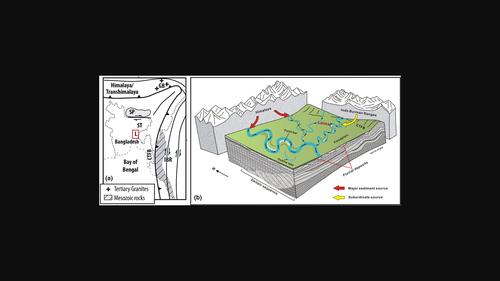当前位置:
X-MOL 学术
›
Geolog. J.
›
论文详情
Our official English website, www.x-mol.net, welcomes your feedback! (Note: you will need to create a separate account there.)
Petrography, geochemistry and detrital zircon U–Pb dating of the Pliocene-Pleistocene Dupi Tila Formation from the Lalmai Anticline, Bengal Basin: Regional tectonic implications
Geological Journal ( IF 1.8 ) Pub Date : 2024-01-17 , DOI: 10.1002/gj.4921 Rumana Yeasmin 1 , Rashed Abdullah 1 , Md. Sakawat Hossain 1, 2 , Songjian Ao 2, 3 , Md. Sharif Hossain Khan 1 , Abu Sadat Md. Sayem 1 , Wenjiao Xiao 2, 3, 4 , Pengpeng Zhang 5 , Aradil Zoarder 1 , Tasnuva Jannat Tithi 1
Geological Journal ( IF 1.8 ) Pub Date : 2024-01-17 , DOI: 10.1002/gj.4921 Rumana Yeasmin 1 , Rashed Abdullah 1 , Md. Sakawat Hossain 1, 2 , Songjian Ao 2, 3 , Md. Sharif Hossain Khan 1 , Abu Sadat Md. Sayem 1 , Wenjiao Xiao 2, 3, 4 , Pengpeng Zhang 5 , Aradil Zoarder 1 , Tasnuva Jannat Tithi 1
Affiliation

|
The Bengal Basin is a well-known foreland basin that archives the tectonic evolution of the Himalayan and Indo-Burman Ranges (IBR). The Dupi Tila Formation is the youngest among the stratigraphic successions of the Bengal Basin, which witnessed the last phase of the Himalayan uplift. However, there is still controversy regarding sediment provenances since the Himalayan and IBR are in the late Neogene exhumation stage. In this study, the petrographical and geochemical compositions of the Dupi Tila sandstones from the Lalmai Anticline of the Bengal Basin are examined to infer the source rocks, tectonic settings, palaeoclimate and weathering intensity in provenance areas. The detrital modes and geochemical discriminations, as well as Chondrite-normalized rare earth elements patterns with enrichment in light rare earth elements and nearly flat heavy rare earth elements and negative Eu anomalies (average Eu/Eu* = 0.77) indicate dominantly felsic source rocks. The geochemical data also suggest that these source rocks in provenance areas were influenced by weak to moderate chemical weathering (chemical index of alteration: 65.64–75.62) and multiple recycling under warm and humid to semi-humid climatic conditions. The detrital zircon ages show three dominant peaks at ca. 100, 500 and 1000 Ma with minor 1700 Ma. The amount of young zircon grains (<120 Ma) is noticeably higher (~18%) in this Lalmai outcrop compared to the Dupi Tila samples from the Sylhet Trough and Chittagong-Tripura Fold Belt. Results from integrated zircon geochronology and geochemistry indicate that the detritus are likely derived from a recycled orogen provenance related mainly to active continental margin setting with subordinate influence from passive setting. Therefore, the regionally extensive Himalayan Orogen appears to be the primary sediment source, with additional mixing from the IBR and recycled sediments originating from the Gangdese batholith of the Trans-Himalaya.
中文翻译:

孟加拉盆地拉迈背斜上新世-更新世 Dupi Tila 组的岩相学、地球化学和碎屑锆石 U-Pb 定年:区域构造意义
孟加拉盆地是著名的前陆盆地,记录了喜马拉雅山脉和印缅山脉(IBR)的构造演化。杜皮蒂拉地层是孟加拉盆地地层序列中最年轻的,见证了喜马拉雅隆起的最后阶段。但由于喜马拉雅和IBR均处于新近纪晚期剥露阶段,关于沉积物物源仍存在争议。在这项研究中,对孟加拉盆地 Lalmai 背斜的 Dupi Tila 砂岩的岩石学和地球化学成分进行了检查,以推断物源区的烃源岩、构造背景、古气候和风化强度。碎屑模式和地球化学判别,以及轻稀土元素富集和近乎平坦的重稀土元素的球粒陨石归一化稀土元素模式以及负Eu异常(平均Eu/Eu* = 0.77)表明烃源岩以长英质为主。地球化学数据还表明,物源区烃源岩受到弱至中度化学风化(化学蚀变指数:65.64~75.62)和温暖湿润至半湿润气候条件下多次再循环的影响。碎屑锆石年龄显示出三个主峰,分别位于约100、500 和 1000 Ma,较小 1700 Ma。与来自锡尔赫特海槽和吉大港-特里普拉邦褶皱带的 Dupi Tila 样品相比,该 Lalmai 露头中年轻锆石颗粒的数量 (<120 Ma) 明显更高 (~18%)。综合锆石年代学和地球化学的结果表明,碎屑可能来自主要与活动大陆边缘环境有关的再循环造山带物源,其次是被动环境的影响。因此,区域范围广泛的喜马拉雅造山带似乎是主要的沉积物来源,另外还混合了来自 IBR 和来自跨喜马拉雅山冈底斯岩基的回收沉积物。
更新日期:2024-01-17
中文翻译:

孟加拉盆地拉迈背斜上新世-更新世 Dupi Tila 组的岩相学、地球化学和碎屑锆石 U-Pb 定年:区域构造意义
孟加拉盆地是著名的前陆盆地,记录了喜马拉雅山脉和印缅山脉(IBR)的构造演化。杜皮蒂拉地层是孟加拉盆地地层序列中最年轻的,见证了喜马拉雅隆起的最后阶段。但由于喜马拉雅和IBR均处于新近纪晚期剥露阶段,关于沉积物物源仍存在争议。在这项研究中,对孟加拉盆地 Lalmai 背斜的 Dupi Tila 砂岩的岩石学和地球化学成分进行了检查,以推断物源区的烃源岩、构造背景、古气候和风化强度。碎屑模式和地球化学判别,以及轻稀土元素富集和近乎平坦的重稀土元素的球粒陨石归一化稀土元素模式以及负Eu异常(平均Eu/Eu* = 0.77)表明烃源岩以长英质为主。地球化学数据还表明,物源区烃源岩受到弱至中度化学风化(化学蚀变指数:65.64~75.62)和温暖湿润至半湿润气候条件下多次再循环的影响。碎屑锆石年龄显示出三个主峰,分别位于约100、500 和 1000 Ma,较小 1700 Ma。与来自锡尔赫特海槽和吉大港-特里普拉邦褶皱带的 Dupi Tila 样品相比,该 Lalmai 露头中年轻锆石颗粒的数量 (<120 Ma) 明显更高 (~18%)。综合锆石年代学和地球化学的结果表明,碎屑可能来自主要与活动大陆边缘环境有关的再循环造山带物源,其次是被动环境的影响。因此,区域范围广泛的喜马拉雅造山带似乎是主要的沉积物来源,另外还混合了来自 IBR 和来自跨喜马拉雅山冈底斯岩基的回收沉积物。



























 京公网安备 11010802027423号
京公网安备 11010802027423号